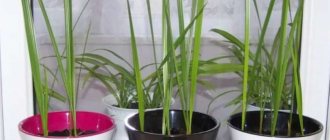- August 14, 2019
- Houseplants
- KatrinGlamour
The fabulous beauty of orchids and their delicate aroma will take your breath away. With each new plant it gets harder and harder to stop. Or maybe it’s not worth it? After all, you can not only buy exotic beauties, but also grow them yourself at home. And to do this, you just need to know how to plant orchids correctly and follow the technology exactly. Having mastered this simple science, you can easily acquire new items and enjoy the beauty you created with your own hands even more.
Planting methods
The first step is to understand the possible methods of planting orchids at home and choose the best option. There are only two landing methods:
- per block;
- in a pot.
The appropriate method depends on the conditions in which you plan to grow your exotic beauty. Although sometimes you need to choose a method based on the variety of the plant itself. And remember: proper planting is only half the success; it is equally important to properly care for the flower, providing it with the necessary microclimate.
Preparing for transplant
To know how to properly transplant an orchid into a new pot, you need to understand the intricacies of preparing for this important operation.
First of all, you should remember - three to four days before transplantation, or better yet a week, you need to stop watering. Unless the house is too hot, in which case it is advisable to move the pot to a shaded place where it is not so hot. Experienced florists recommend replanting orchids when their roots are slightly dry on the outside (but not completely dry!). When the substrate in the pot is completely dry, move on to the next step and try to figure out how to transplant the orchid into another pot.
Features of landing on the block
This is a fairly common method of breeding orchids, gaining more and more popularity every year. For planting, use any suitable material to which the plant can be attached. For example, a piece of oak, pine or tree fern bark is suitable.
The dimensions of the material are selected taking into account the size of the plant itself and the specifics of its growth. Choosing the right base size is a very important step. After all, if it does not fit, the flower will have to be replanted, which will negatively affect its development and condition. Remember: every transplant is a lot of stress for a plant.
What is the benefit of planting orchids on a block? First of all, the roots of the flower dry out quickly after each watering. In addition, they receive much more oxygen, which is very useful.
And the plant on the block looks more natural and beautiful. In this way, you can plant orchids that will be moved to a greenhouse in the future. In such conditions they will not have a lack of moisture, so they will not lose it during the dormant period.
Features of planting in a pot
For orchids, a flowerpot is not exactly a container, but rather a support. You should choose a pot depending on the needs of the flower and the conditions in which it will be located.
In addition to traditional flowerpots, baskets are often used to grow orchids. Indeed, in the natural environment, some types of flowers happily live on the forks of trees and even on stumps. Such plants most often have penetrating, hanging peduncles. In order not to lose buds, it is best not to plant such varieties in a pot, but to use a basket. In this case, the plants will hang down just like in nature. But it is worth considering that in such a container the soil will dry out very quickly.
Preparatory work
Preparation for planting consists of preparing planting materials: pot, support, mixture. Analyze the conditions in which the orchid should grow and keep in mind that not all of them grow in a pot.
Some orchids grow on a support created from a piece of bark and moss. The plant is planted on moistened moss, then its roots are covered with a second layer of moss, it is secured and the plant is suspended in the air - in a basket or on the wall.
Varieties growing in a pot - Phalaenopsis, Molina, Vanda. Their roots participate in photosynthesis, so they need a transparent pot. It can be glass or plastic. The substrate will be placed in the pot. These are peat, bark and other materials that support the root system, easily allow air to pass through and do not retain moisture.
Did you know? Vanilla orchid
—
This is the only type of orchid that is grown commercially. Its fruits are used in cooking.
Preparing the container
When purchasing a pot, you will probably come across many options: glass, plastic and ceramic. Some are more decorative. But they have functional differences. Also, each material has its own advantages, and which one you choose may depend on the type of orchid you are planting.
The most common is a plastic transparent pot. Designed for sympodial orchids, the roots of which participate in the process of photosynthesis along with the entire plant. Tall and narrow pots suit plants with extra long roots, such as Asian cymbidiums.
The size and number of drainage holes matters. Better drainage is provided by pots that have holes not only at the bottom of the pot, but also on the sides.
Main types of pots:
- mesh basket for plants that will be planted on a support; the same type of wooden baskets made from teak or other wood; You can plant several orchids in one such pot;
- transparent plastic for those whose roots need sunlight;
- containers with a mesh insert to enhance drainage and air circulation;
- pots with two-level drainage , domed bottom, with a large number of drainage holes.
Important! Pot proportional to the root system
-
this is not a whim, but a concern for flowering.
Once in a large pot, the orchid will begin to fill it with roots and will not bloom until it is finished with this task. But the most important thing is that the pot should be only 2–3 cm larger than the orchid’s root ball. Any of the pots must have a good drainage system.
Video: Choosing a pot for an orchid
Soil selection and treatment
The main thing you need to know about soil is that it is the material on which the orchid rests. It can consist of sphagnum moss, spruce bark, coconut husks, charcoal, sawdust and any other porous material, even pieces of foam.
The most common mixture:
- bark or coconut husk, sawdust;
- fine charcoal;
- perlite
Parts ratio: 4:1:1. A practical solution would be to use a store-bought orchid mixture.
Plants that grow in temperate climates need soil that can retain water well but be sufficiently drained. These are mainly cymbidiums. They grow both in soil and on trees. These flowers are distinguished by long narrow leaves and several flowering branches.
To prepare the substrate for planting you need to:
- Mix all ingredients in a large container.
- Pour the mixture with hot water (+75°C), completely covering the mix with water.
- Let it brew for a day.
- Drain the water. Third-party impurities will be merged with it.
Filling with hot water is needed to destroy fungal spores and other pathogenic microorganisms. Now the mixture will dry and you can plant.
Did you know? One orchid seed pod can contain up to 3 million seeds. But you won't see them. They are so small that they can only be seen under a microscope.
Choosing a suitable substrate
Soil is the main element of any plant. It is on this that the well-being and well-being of the flower rests. If this is your first time starting to grow orchids, then buy suitable soil at the store. And if you have many years of experience and a wealth of knowledge in this area, then it will probably not be difficult for you to prepare a high-quality mixture yourself. In this case, it is necessary to take into account a number of soil characteristics.
- The soil components must be crushed. Huge pieces of bark are no longer a substrate, but a block.
- Do not use garden soil that has low breathability.
- Remember that soil is not only the basis for a plant, but also a home for all kinds of bacteria. So be sure to sanitize all ingredients before preparing it.
When will it bloom?
When growing home orchids in a pot, florists value them for their beautiful flowers. Of course, they are interested in how long after transplantation the plant will begin to bloom.
In fact, orchids are easier to replant than most house plants. Therefore, if everything was done correctly, it will bloom in due time. An exception may be cases when the transplant was carried out shortly before the buds opened. At the same time, the orchid will probably shed its buds so as not to waste excess moisture and nutrients on the flowers.
Features of soil preparation
Soil can be formed from different components.
- Pine and deciduous bark. It should be dried, without a single hint of rotting.
- Fern roots. It needs to be cut into pieces of 3-4 cm, and only then dried.
- Moss. Remember: only one type is suitable - sphagnum. The moss should also be well dried. In orchid soil it is necessary for the accumulation of moisture.
- Pumice. Excellent for drainage.
- Charcoal. It has antiseptic properties and regulates soil acidity. Its amount should be no more than 5% of the total soil.
- Expanded clay. It works well as drainage, but is also suitable for creating a substrate.
Here are some soil options for orchids.
- Five parts of pine bark, one part each of charcoal and sphagnum, pumice and expanded clay for drainage.
- Pine bark and charcoal in proportions 5:1.
- Five parts pine bark and wood chips, two parts moss and half the amount of charcoal.
Any substrate prepared according to these recipes is ideal for growing orchids at home.
Choosing a pot
When choosing a flowerpot for your flower, be sure to take into account how it grows in its natural environment. Orchids do not send down their roots, but grow wider. So the pot for such a flower should not be deep, but wide. This is the only way to avoid root rotting.
In the tropics, which are native to orchids, the daylight hours are very long, so they love plenty of natural light. That is why they are so often planted in pots with transparent walls. In addition, this way you can avoid unnecessary watering. After all, through the walls you can see everything that happens inside the pot.
How to plant an orchid? For this, it is best to take a ceramic, plastic or glass pot. But you should refrain from using wicker and clay flowerpots - the roots of orchids grow tightly to them. If you choose a glass flowerpot, remember one golden rule: you cannot place the orchid in it in direct sunlight. And all because the walls of such a pot refract the rays, and the plant can get a serious burn.
In general, experienced gardeners agree on one opinion: a plastic pot is ideal for planting an orchid. In such a container the flower will be as comfortable as possible.
Strengthening the orchid
Unlike many other ornamental plants, the orchid does not have thin root shoots that would quickly develop and fix it in the ground. Therefore, we need to help her in this matter. After all, even movements of a few millimeters will inevitably lead to the orchid stopping growth for a while. This is especially noticeable in cases where the sensitive tips are damaged due to movement.
You can cope with the task in different ways. For example, stores have special fasteners in the form of thin wire. It is fixed on the pot, after which it secures the plant.
You can also stick a long, strong stick (like those that come with rolls and sushi) into the ground (carefully, without damaging the roots) and tie an orchid to it.
Some flower lovers wrap the plant with nylon tights several times, securing them relative to the pot. Yeah, it's not too pretty. But this is a temporary measure - after a few weeks, the tights can be safely removed, since the orchid will already be fixed in the pot.
How to plant orchids at home from seeds
Perhaps this method is the most labor-intensive. Orchid seeds are so small that they can be mistaken for dust. During germination, they can die from any, even the most insignificant, external influence. So to plant seeds you will need greenhouse conditions.
In the process, you will need glass jars or flasks with lids in which you need to make holes. This is necessary to provide a nutrient medium for the seeds. And don't forget to sterilize the jars. Buy a special mixture for seed germination at the store.
And now about how to plant orchids. Heat the purchased mixture and pour it into prepared containers. Disinfect the seeds by placing them in a bleach solution for 10 minutes. Then add them to the mixture and seal the containers tightly.
In about a week you will notice the first leaves, and soon the roots will appear. True, it will be possible to transplant the sprouts only after a year, when they are fully strengthened. At the same time, you need to take them out and replant them very carefully so as not to damage the fragile plants.
In what cases should an orchid be replanted?
There are several signs by which an experienced florist will instantly understand that he will have to get his hands dirty when replanting. For example, the question of how to transplant an orchid into another pot is worth asking if a persistent smell of rot, dampness and mold emanates from the plant - this is a very alarming signal. If the work is not done on time, the orchid may well die.
A compressed substrate is also a bad sign. Monitor the level of the soil in the pot - if it crumples and sinks a few centimeters, then the root system is in danger. At the same time, the appearance of the orchid changes - it takes on a withered appearance, indicating that something is clearly wrong with it. Finally, you need to keep an eye on the roots. It is no coincidence that you can often see special transparent pots for orchids on sale - we’ll talk about them a little later. The roots are healthy if they remain green. But gray or brown colors are a very alarming sign. If you notice this, be sure to replant the orchid.
How to plant an orchid at home from a bulb
The size and shape of the bulbs may vary.
How to plant orchids this way? Bulbs can produce leaves and flower stalks, so they are planted to grow flowering plants. Choose a healthy onion - it should be firm and slightly firm. Refrain from purchasing a wrinkled, soft tuber.
How to plant an orchid? There are two ways to do this.
- The bulb can be left in the room in a bright place without soil. At the same time, it does not need to be sprayed or watered. After 3-4 weeks, the first roots should appear on the bulb. At this time, the bulb can already be transplanted into the soil.
- For the second method, you will need a disposable cup with holes on the sides and bottom. Place sphagnum moss inside the container, an orchid bulb on top, and then another layer of moss.
In both the first and second cases, the flower should not be overly flooded with water and should not be placed in dense soil.
How often should I transplant?
A purchased orchid is not always contained in a high-quality substrate. If the plant looks healthy, there is no reason to touch it. The flower is left in the shipping container until next year. If, instead of a substrate, pieces of compressed moss or foam rubber are found, replanting even a flowering plant is carried out urgently. Delay can lead to rotting of the root collar or roots.
The orchid is sensitive to changes in the environment, and subsequent adaptation may take a long time. In the absence of signs of root disease, the planned procedure is carried out no more than once every 3 years.
Growing up from baby
A baby is a small shoot on the root or peduncle of an orchid, which over time becomes an independent flower. This method of planting requires a minimum of time and effort. The plant itself from which the baby is separated does not suffer one bit.
How to plant an orchid from a cutting? The plant can be divided only when roots have appeared on the plant.
In the process, you will need a transparent container, crushed pine bark, charcoal and moss.
Place the shoot at the bottom of the dish and fill the remaining space with substrate. Make sure that the sprout has support. And one more thing: do not try to compact the soil tightly - the soil should be loose.
Features of care
Now you know how to plant an orchid at home. But this is only half the success, because the development of the flower largely depends on further care. Growing an orchid is quite painstaking work. But knowing the intricacies of care, you can easily cope with this task.
- Lighting. Orchids love light, but the sun's rays should only be diffused and not direct. Lighting plays a special role in winter. The orchid requires a 12-hour shift, so during the cold season it needs to be provided with artificial lighting. If this is not done, the flower will begin to fade and perhaps even die.
- Temperature. The orchid feels most comfortable at 20-25 degrees. If the thermometer is less than 12 degrees, the plant will die. Too high an indicator will also negatively affect the development of the flower - over time it will begin to fade.
- Humidity. Orchids love high humidity. The ideal figure for them is 60-70%. True, this is only possible in greenhouse conditions. It is enough to simply install household humidifiers in the room. The room should be ventilated periodically, but the orchid should be taken out. After all, she does not tolerate drafts well. It is advisable to spray the air in the room three times a day in summer and once in winter. At the same time, make sure that water does not get on the flowers and leaves of the plant.
- Watering. You need to water the orchid with soft, warm water, preferably melt or rain. If you don’t have one, use settled or boiled water. In summer you need to water the flower every three days, and in winter - once a week.
- Nutrition. The plant should be fed every 3 weeks. In this case, the procedures must be alternated with washing the roots. You can only use special fertilizers, like Bona Forte. You don’t have to feed the plant at all, but you will need to change the soil every 2 years.











